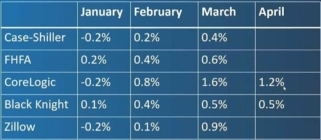
The entire Mortgage Industry is in a state of panic right now.
This is b/c so many potential borrowers could skip or miss payments, and b/c the Fed is pushing mortgage rates down too quickly and putting enormous financial pressure on mortgage lenders.
Mortgage lenders and servicers are both facing enormous losses for a variety of complex reasons that Barry Habib explained yesterday in an excellent and widely circulated article that I highly recommend – set out at the bottom of this blog.
FORBEARANCES OR THE ABILITY TO NOT MAKE MORTGAGE PAYMENTS
Many borrowers will be eligible for forbearances if their loans are owned by Fannie Mae or Freddie Mac, or if they are held by certain major banks (depending on the state a borrower is in).
Many borrowers may not be eligible for forbearances, however, if their loan is held by an investor instead of Fannie, Freddie or a major bank.
Here is a link to a CFPB page that explains how to find out who holds a borrower’s mortgage.
Borrowers should keep in mind that forbearances are not a free lunch, as the missed payments have to be made up later on.
Borrowers should also not refinance or go through with their purchase if they think they might need a forbearance. This is for two reasons: (1) it will be far more difficult to get “forbearance approval” for a newly funded loan b/c ownership of the loan will be in a state of flux for some time, as is the case for all new loans; and (2) missed payments for a newly funded loan can cost a mortgage lender hundreds of thousands of dollars in penalties – I cannot overstate this risk, as it is extreme.
Borrowers with loans in escrow who are facing a potential hardship should put their transaction on hold and then resume once this crisis ebbs. Interest rates will very likely be equally low or lower in any case.
LENDERS REFUSING TO FUND LOANS – JUMBO AND NON-QM
Many mortgage banks are simply refusing to fund jumbo and non-QM (quasi sub-prime) loans now b/c they have nobody to sell them to.
Remember that mortgage banks fund all of their loans with large lines of credit called “warehouse lines.” They do not fund loans with deposits or cash on hand like a commercial bank might.
Mortgage banks must sell every loan they fund to make money, to survive, and to satisfy warehouse line lender and regulator rules.
If lenders are unable to sell loans, they can’t survive.
Hence, a mortgage bank will refuse to fund a mortgage loan if there are no buyers in the marketplace like what is happening now with jumbo and non-QM loans.
The jumbo market will probably return to some sense of normality within a few weeks but the non-QM market could be out of commission for months or even longer.
VANILLA LOANS
Lenders will only be funding relatively clean “vanilla” loans for a while now. They will shun tough or marginal deals b/c of the likelihood that they will not be able to find a buyer for that loan.
NO NEED TO FREAK OUT 😊
While rates are higher than expected, particularly for some types of jumbo loans, the mortgage industry is still funding loans and rates are still excellent from a historical perspective.
Further, many pundits expect rates to fall again.
So, buyers who need to close soon should take what they can get and then look to refinance later on.
Going from lender to lender will just result in massive delays and continued frustrations and disappointment.
I say this b/c we are getting panicked calls from buyers who are with other lenders.
While our rates are a bit lower in many cases, we cannot offer fast closes and we don’t want to force buyers to start the entire process over in this tough market.
Hence, we usually advise concerned buyers to stick with their current lender – unless their rate is ridiculously high or unless the lender simply can’t perform.
Jay Voorhees
Founder/Broker | JVM Lending
(855) 855-4491 | DRE# 1197176, NMLS# 310167
Mortgage Crisis and Fed Unintended Consequences
March 26, 2020
By Barry Habib of MBS Highway
The Coronavirus Meltdown
The current Coronavirus crisis is having a critical impact on the Mortgage Industry, which could potentially make the 2008 financial crisis pale in comparison. The pressing issue centers around capital that’s required by Mortgage Lenders to be able to function and meet covenants that are required for them to continue to lend.
Here’s How the Mortgage Market Works
Let’s begin with the mortgage process. A borrower goes to a Mortgage Originator to obtain a mortgage. Once closed, the loan is handled by a Servicer, which may or may not be the same company that originated the loan. The borrower submits payments to the Servicer, however, the Servicer does not own the loan, they are simply maintaining the loan. This means collecting payments and forwarding them to the investor, paying taxes and insurance, answering questions, etc. While they maintain or “service” the loan, the asset itself is sold to an aggregator or directly to a government agency like Fannie Mae (FNMA), Freddie Mac (FHLMC), or Ginnie Mae (GNMA). The loan then gets placed inside a large bundle, which is put in the hands of an Investment Banker. That Investment Banker converts those loans into a Mortgage Backed Security (MBS) that can be sold to the public. This shows up in different investments like Mutual Funds, Insurance Plans, and Retirement Accounts.
The Servicer’s role is very critical. In order to obtain the right to service loans, the Servicer will typically pay 1% of the loan amount up front. The Servicer then receives a monthly payment or “strip” equal to about 30 basis points (bp) per year. Because they paid about 1% to obtain the servicing rights and receive roughly 30bp in annual income, the breakeven period is approximately 3 years. The longer that loan remains on the books, the more money that Servicer makes. In many cases, the Servicer might want to use leverage to increase their level of income. Therefore, they may often finance half of the cost of acquiring the loan and pay the rest in cash.
Servicer Dilemma
As you can imagine, when interest rates drop dramatically, there is an increased incentive for many people to refinance their loans more rapidly. This causes the loans that a Servicer had on their books to pay off sooner…often before that 3-year breakeven period. This servicing runoff creates losses for that Mortgage Lender who is servicing the loan. The more loans in a Mortgage Lender’s portfolio, the greater the loss. Servicing runoff, or even the anticipation of it, can adversely impact the market valuation of a servicing portfolio. But at the same time, Lenders typically experience an increase in new loan activity because of the decline in interest rates. This gives them additional income to help overcome the losses in their servicing portfolio.
But the Coronavirus has caused a virtual shutdown of the US economy, which has created an unprecedented amount of job losses. This adds a new risk to the servicer because borrowers may have difficulty paying their mortgage in a timely manner. And although the Servicer does not own the asset, they have the responsibility to make the payment to the investor, even if they have not yet received it from the borrower. Under normal circumstances, the Servicer has plenty of cushion to account for this. But an extreme level of delinquency puts the Servicer in an unmanageable position.
“I’m From the Government And I’m Here To Help”
In the Government’s effort to help those who have lost their jobs because of the Coronavirus shutdown, they have granted forbearance of mortgage payments for affected individuals. This presents an enormous obstacle for Servicers who are obligated to forward the mortgage payment to the investor, even though they have not yet received it. Fortunately, there is a new facility set up to help Mortgage Servicers bridge the gap to the investor. However, it is unclear as to how long it will take for Servicers to access this facility.
But what has not been yet contemplated is the fact that a borrower who does not make their very first mortgage payment causes that loan to be ineligible to be sold to an investor. This means that the Servicer must hold onto the asset itself, which ties up their available credit. And with so many new loans being originated of late, the amount of transactions that will not qualify for sale is significant. This restricts the Lender’s ability to clear their pipeline and get reimbursed with cash so they can now fund new transactions.
Mark to Market
This week – Due to accelerated prepayments and the uncertainty of repayment, the value of servicing was slashed in half from 1% to 0.5%. This drastic decrease in value prompted margin calls for the many Servicers who financed their acquisition of servicing. Additionally, the decreased value of a Lender’s servicing portfolio reduces the Lender’s overall net worth. Since the amount a lender can lend is based on a multiple of their net worth, the decrease in value of their servicing portfolio asset, along with the cash paid for margin calls, reduces their capacity to lend.
Unintended Consequences
The Fed’s desire to bring mortgage rates down isn’t just damaging servicing portfolios because of prepayments, it’s also wreaking chaos in Lenders’ ability to hedge their risk. Let’s look at what happens when a borrower locks in their mortgage rate with a Mortgage Lender. Mortgage rates are based on the trading of Mortgage Backed Securities (MBS). As Mortgage Backed Securities rise in price, interest rates improve and move lower. A locked rate on a mortgage is nothing more than a Lender promising to hold an interest rate, for a period of time, or until the transaction closes. The Lender is at risk for any MBS price changes in the marketplace between the time they agreed to grant the lock and the time that the loan closes.
If rates were to rise because MBS prices declined, the Lender would be obligated to buy down the borrower’s mortgage rate to the level they were promised. And since the Lender doesn’t want to be in a position of gambling, they hedge their locked loans by shorting Mortgage Backed Securities. Therefore, should MBS drop in price, causing rates to rise, the Lender’s cost to buy down the borrower’s rate is offset by the Lender’s gains of their short positions in MBS.
Now think about what happens when MBS prices rise or improve, causing mortgage rates to decline. On paper the Lender should be able to close the mortgage loan at a better price than promised to the borrower, giving the Lender additional profits. However, the Lender’s losses on their short position negate any additional profits from the improvement in MBS pricing. This hedging system works well to deliver the borrower what was promised, while removing market risk from the Lender.
But in an effort to reduce mortgage rates, the Fed has been purchasing an incredible amount of Mortgage Backed Securities, causing their price to rise dramatically and swiftly. This, in turn, causes the Lenders’ hedged short positions of MBS to show huge losses. These losses appear to be offset on paper by the potential market gains on the loans that the lender hopes to close in the future. But the Broker Dealer will not wait on the possibility of future loans closing and demands an immediate margin call. The recent amount that these Lenders are paying in margin calls are staggering. They run in the tens of millions of Dollars. All this on top of the aforementioned stresses that Lenders are having to endure. So, while the Fed believes they are stimulating lending, their actions are resulting in the exact opposite. The market for Government Loans, Jumbo Loans, and loans that don’t fit ideal parameters, have all but dried up. And many Lenders have no choice but to slow their intake of transactions by throttling mortgage rates higher and by reducing the term that they are willing to guarantee a rate lock.
Furthering the Fed’s unintended consequences was the announcement to cut interest rates on the Fed Funds Rate by 1% to virtually zero. Because the Fed’s communication failed to educate the general public that the Fed Funds Rate is very different than mortgage rates, it prompted borrowers in process to break their locks and try to jump ship to a lower rate. This dramatically increased hedging losses from loans that didn’t end up closing.
Even Stephen King Could Not Have Scripted This
It’s been said that the Stock market will do the most damage, to the most people, at the worst time. And the current mortgage market is experiencing the most perfect storm. Just when volume levels were at the highest in history, servicing runoff at its peak, and pipelines hedged more than ever, the Coronavirus arrived.
Lenders need to clear their pipelines, but social distancing is making it more difficult for transactions to be processed. And those loans that are about to close require that employment be verified. As you can imagine, with millions of individuals losing their jobs, those mortgages are unable to fund, leaving lenders with more hedging losses and no income to offset it.
What Needs To Be Done Now
Fortunately, there are many smart people in the Mortgage Industry who are doing everything they can to navigate through these perilous times. But the Fed and our Government needs to stop making it more difficult. The Fed must temporarily slow MBS purchases to allow pipelines to clear. Lawmakers need to allow for first payment defaults, due to forbearance, to be saleable. And finally, the Fed must more clearly communicate that Mortgage Rates and the Fed Funds Rate are not the same.
We have faith that the effects of the Coronavirus will subside and that things will become more normalized in the upcoming months.
























